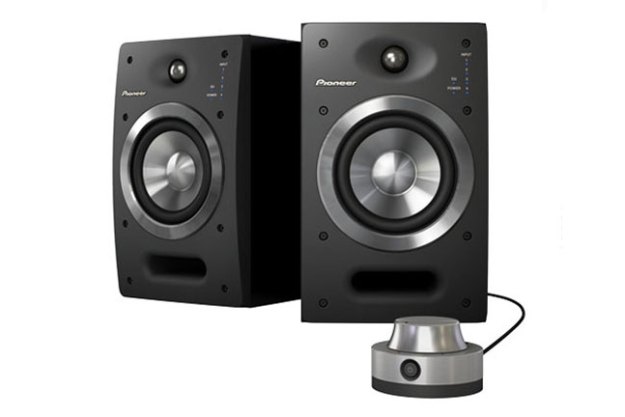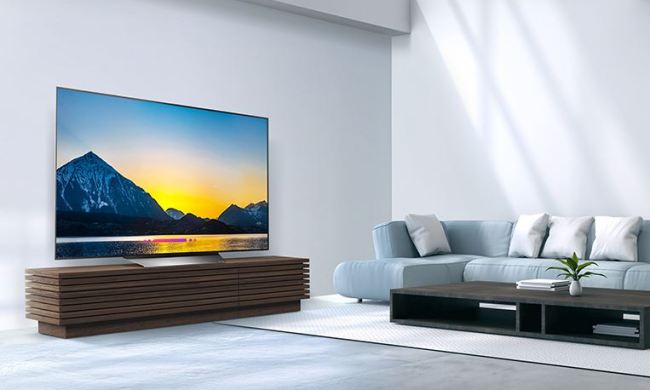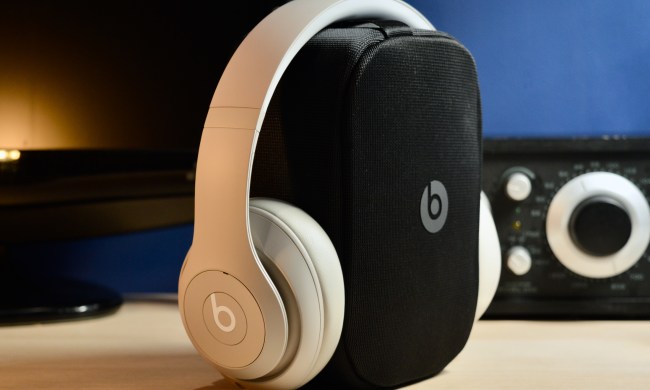
“We’re very pleasantly surprised with Pioneer’s first efforts at an active monitor. Its neutral sound and linear response should find themselves at home in smaller project studios.”
- Clean, neutral, well-balanced sound
- Rock-solid cabinet construction
- XLR, ¼-inch and RCA inputs
- Convenient control module
- Mounting holes require specific bracket
Have you noticed how many people call themselves DJs these days? Chances are, you either know someone who is a DJ, or know someone who has a DJ friend. Perhaps this is because the digital age has morphed the face of DJ equipment. Or maybe it’s because DJ Hero has exposed the art form to a massively wide demographic, sucking in would-be disc-spinners aged 8 to 80 (yeah, probably not). Whatever the case, it sure seems like there’s a long line of people itching to jump on the DJ bandwagon.
It comes as no big surprise to us, then, that Pioneer is positioning its new active reference speakers as DJ speakers. Considering the exploding DJ scene, why not? Brand it as you will, the S-DJ05 and S-DJ08 are active monitors and, as such, have applications in all sorts of professional audio scenarios such as project studios, recording studio start-ups and, of course, any instance where a DJ wants to hear superior reproduction of their mixes.
Pioneer is no stranger to DJ gear. The company has a huge selection of mixers, digital turntables, controllers, effects, headphones and accessories. Considering Pioneer’s position in the speaker and electronics fields, we’d say it has as much business building active monitors as, say, Yamaha or JBL. Yet, the S-DJ05 and S-DJ08 are the company’s first active speakers under the DJ moniker. When you think about it, it’s kind of surprising Pioneer is just getting around to it. Let’s see how the folks at Pioneer did their first time out.
Out of the box
At about 15 pounds apiece unpacked, the S-DJ05 speakers let you know they deserve to be taken seriously right away. Much of the weight is due to the built-in power supply, but the speakers’ stout cabinetry is a clear contributor as well. One rap with the knuckles revealed the cabinets to be about as acoustically inert as you could hope to get.

Along with the speakers, the S-DJ05 include two lengthy power cords (nice touch), a control module, two control link cables and eight rubber feet.
Features
It was the S-DJ05’s comprehensive list of features that caught our eyes in the first place. Let’s start with the back panel of each speaker, which offers plenty of different input options. Each speaker has one balanced XLR, one balanced ¼-inch (TRS) and two unbalanced RCA inputs for a total of four input options. The speakers are bi-amplified with 22 watts RMS (50 watts dynamic) going to each low-frequency driver and 18 watts RMS (30 watts dynamic) going to each high-frequency driver. That’s a total system power rating of 80 watts RMS. In other words: plenty.

The control module, like the speakers themselves, is robustly constructed and feels solid in the hand. It’s just the right size to comfortably lay your hand on and naturally manipulate the controls. The volume wheel on top actually glides so smoothly, we found ourselves playing around with it just for fun. The rest of the well-placed controls sit on the outer diameter of the control dial. At the 11 o’clock position (perfectly placed for our left ring finger) is a mute/EQ button. At the 1 o’clock position (ideal for our index finger) we find the input selector. At the 6 o’clock, smartly placed out of the way, is the power button. It’s handy enough, but not likely to get punched by accident. The control module’s cord is about 12 feet long, as is the jumper that runs to the opposing speaker — plenty long for most small studio situations.
As for the face of the S-DJ05… well, let’s just say beauty is in the eye of the beholder. Some of us appreciated the smudge-resistant charcoal baffle and aluminum driver cone with ornamental surround. Others, not so much. There’s something classically Pioneer about it, though.
Top to bottom, the front of the speaker features a 1-inch silk dome tweeter, a 5-inch mid-bass driver and a flared port. Along the top right hand side of each speaker runs a vertical series of LEDs indicating power status, EQ status and input number.
Performance
To test the S-DJ05, we used a variety of test tracks that included 96kHz/24-bit FLAC files, uncompressed and unmastered WAV files from a recent live recording session, some DVD-Audio discs and standard CDs. Associated equipment included a Dell N5110 Laptop, a Headroom Micro DAC processing at 48kHz/16bit, a NuForce Icon u2 DAC processing at 96kHz/24bit, a Cardas clear USB cable, a ⅛-inch to L/R ¼-inch adapter and AudioQuest RCA interconnects.
Though it would have been fun to use a balanced connection to the S-DJ05, perhaps with a pro-audio DAC, we feel that our test bench in this situation provided a revealing sample of what these active monitors are capable of. Those readers who have experienced the benefit of balanced audio connections can probably imagine the relative improvement in sound quality that would be experienced using professional audio gear as opposed to the consumer-level equipment used in our evaluation which, we’d like to note, is likely representative of what a large portion of the demographic for these speakers will be using.
Before we began making any critical evaluations, we gave the speakers a good 40 hours to break in, though we have a feeling they may already been broken in when they arrived. We left the EQ out of the equation for most our testing. We checked it out toward the end of our audition to verify it functioned, but found we didn’t need to employ it for the speakers to suit our taste.
We first queued up a Warner remaster of Dire Straits’ Love Over Gold. With most speaker auditions, we usually manage to hold out for four minutes or so before moving on to the next track. We’ve heard most of these recordings several hundred times, so it’s pretty easy to make an observation in short order. This time, though, we found ourselves closely paying attention to all 14 minutes and 20 seconds of “Telegraph Road,” The S-DJ05 are engaging and yield a great amount of inner detail. This remastered version of a Dire Staits classic is definitely on the bright side, but we found the speakers’ silk dome tweeters handling the aggressive cymbals and snare drum with finesse. Guitar picking was precise and full of attack, and Knopfler’s voice came through without a hint of headiness, an issue common with smaller speakers that try to force out bass they have no right trying to handle. The S-DJ05 deftly avoided this pitfall. At the end of the track, we wound up feeling like we knew it a little bit better than before — always a good sign with a set of speakers.
Next, we pulled our FLAC version of Steely Dan’s Gaucho. It’s no wonder this is one of the most overused audiophile demonstration recordings on the planet. It just sounds great. We experienced it once again both at CD resolution (due to USB limitations) through our Headroom DAC and at full resolution with the NuForce DAC. Though the higher resolution version yielded more exposed detail, both versions sounded great through the S-DJ05. We loved the way the Brecker Brothers’ horns came across with such incredibly gritty texture. Also apparent was the precise synchronicity with which the speakers interacted. We expect that precision from an active monitor, and the S-DJ05 deliver.

The S-DJ05 produce the linear, uncolored response you would demand from a much more expensive monitor. They are not without their limitations, though. The 5-inch drivers can’t deliver the deeper bass that we imagine the 8-inch drivers and larger cabinets in the S-DJ08 could, but the bass they do produce is punctual, fast and tonally accurate. If you don’t need bass big enough to rock the entire house, the S-DJ05 are capable of delivering very accurate and musical sound reproduction.
Conclusion
We’re very pleasantly surprised with Pioneer’s first efforts at an active monitor. Its neutral sound and linear response should find themselves at home in smaller project studios, with both new and well experienced DJs, and with just about anyone else that is looking for a self-contained, premium audio solution for their media. We appreciate the versatility and user-friendly controls Pioneer integrated into this line of speakers as well. The control module is not only useful, but has a great feel to it that adds to the user’s enjoyment of the product.
We know our fair share of recording engineers. Each and every one of them is exceptionally picky about the reference monitors they use to mix and master their recordings, and they should be. Since any given reference monitor is likely to appeal to a small segment of very picky listeners, it is impossible to say whether the S-DJ05 or S-DJ08 will be to any particular person’s liking. We can, however, say that both of these offerings from Pioneer stand up very well to the competition and deserve some serious consideration, even if the brand is new to this slice of the market.
Highs:
- Clean, neutral, well-balanced sound
- Rock-solid cabinet construction
- XLR, ¼-inch and RCA inputs
- Convenient control module
Lows:
- Mounting holes require specific bracket





